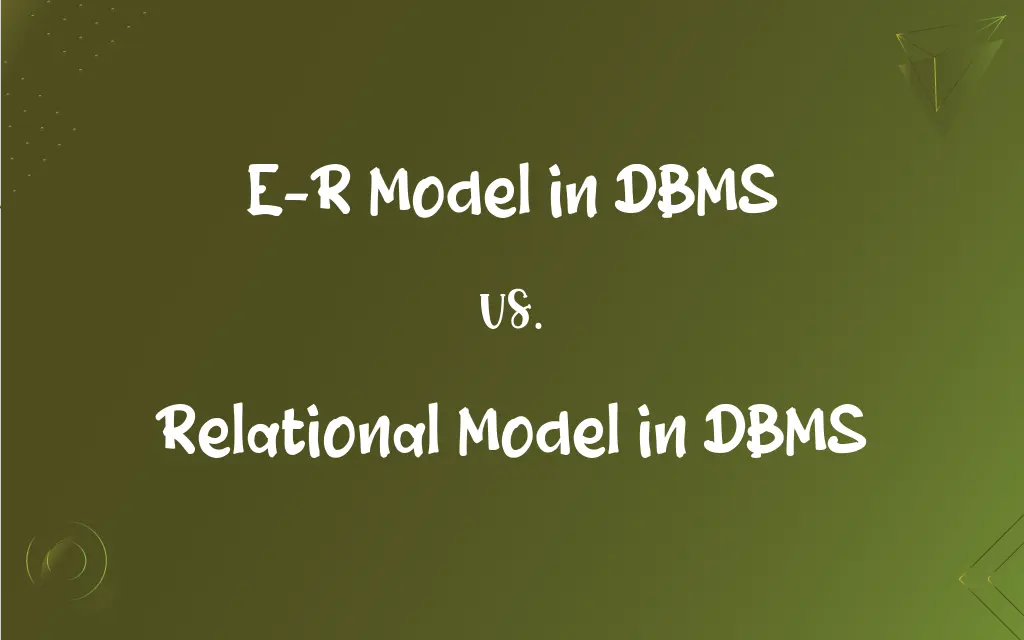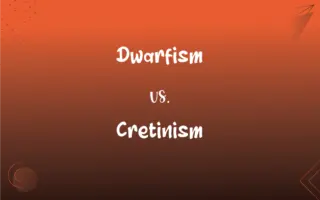E-R Model in DBMS vs. Relational Model in DBMS: What's the Difference?
Edited by Aimie Carlson || By Harlon Moss || Published on February 6, 2024
The E-R Model in DBMS represents entities and their relationships, while the Relational Model organizes data into tables with rows and columns.

Key Differences
The E-R Model in DBMS is a conceptual representation focusing on the relationships between data entities. In contrast, the Relational Model is a practical approach that organizes data into tables, which are interconnected through shared data attributes.
In the E-R Model, entities are defined along with their attributes and the relationships between these entities. The Relational Model, however, structures data into rows and columns, where each row represents a record and each column represents a data attribute.
The E-R Model is primarily used in the database design phase to map out the overall structure of the database. The Relational Model is used for the actual implementation and management of the database, leveraging SQL for data manipulation.
The E-R Model helps in visualizing the database structure through diagrams, while the Relational Model focuses on how data is stored, accessed, and manipulated in a database system.
The E-R Model aids in understanding the logical relationships between different data items, whereas the Relational Model provides a more technical and detailed view of how data is organized and related within the database.
ADVERTISEMENT
Comparison Chart
Primary Focus
Entity relationships and data organization
Data storage in tables with rows and columns
Use in Database Lifecycle
Used in design and conceptual modeling
Used in implementation and data management
Representation
Diagrammatic with entities and relationships
Tabular with records and attributes
User Interaction
More abstract and conceptual
Direct through SQL and database queries
Complexity in Design
Higher due to abstract modeling
Lower, focused on practical data organization
ADVERTISEMENT
E-R Model in DBMS and Relational Model in DBMS Definitions
E-R Model in DBMS
It is a conceptual framework for database design.
The designer used the E-R Model to plan the database structure.
Relational Model in DBMS
The Relational Model organizes data in tables.
The database used the Relational Model to store customer data.
E-R Model in DBMS
The E-R Model is used in the initial stages of database design.
The E-R Model was created before the database was implemented.
Relational Model in DBMS
It uses rows and columns to represent data.
Each row in the relational table represented a unique order.
E-R Model in DBMS
The E-R Model helps in understanding data relationships.
The E-R Model clarified the link between products and suppliers.
Relational Model in DBMS
The Relational Model is based on a set of mathematical concepts.
The Relational Model provided a formal structure for the database.
E-R Model in DBMS
It defines entities, attributes, and their interconnections.
In the E-R Model, attributes of the 'Employee' entity were defined.
Relational Model in DBMS
It facilitates data manipulation and querying.
SQL queries were used to retrieve data from the relational database.
E-R Model in DBMS
The E-R Model visualizes entities and their relationships.
The E-R diagram showed how customers and orders were connected.
Relational Model in DBMS
The Relational Model is practical for database implementation.
The database was built following the principles of the Relational Model.
FAQs
What is the Relational Model in DBMS?
A method for structuring data in tables using rows and columns.
How is the E-R Model used in database design?
For conceptualizing the database structure and relationships.
What is the E-R Model in DBMS?
A conceptual framework for representing entities and their relationships.
What is the primary purpose of the Relational Model?
To implement and manage data in a database system.
Does the Relational Model use SQL?
Yes, SQL is used for querying and managing data in this model.
Is the Relational Model suitable for practical database implementation?
Yes, it is widely used for actual database creation and manipulation.
Are SQL queries part of the E-R Model?
No, SQL is used in the Relational Model, not in the E-R Model.
Does the E-R Model involve diagrammatic representation?
Yes, it uses diagrams to illustrate entities and their connections.
How does the Relational Model represent data?
As a collection of tables with records and attributes.
Are entities and relationships key components of the E-R Model?
Yes, they are fundamental to the E-R Model's structure.
Is the E-R Model specific to any database system?
No, it's a general approach applicable to various systems.
Is the E-R Model more abstract than the Relational Model?
Yes, it's more conceptual, focusing on logical relationships.
What is the role of attributes in the E-R Model?
They define the properties and characteristics of entities.
How does the Relational Model handle data integrity?
Through constraints like primary keys and foreign keys.
Does the Relational Model dictate a specific database software?
No, it's a theoretical model implemented by various database systems.
Do both models support normalization?
The Relational Model directly supports normalization; the E-R Model aids in its conceptualization.
Can the E-R Model exist without a Relational Model?
Yes, as it's a preliminary design step independent of implementation.
How do the E-R and Relational Models interact in database design?
The E-R Model guides the structure, which is then implemented using the Relational Model.
Is the E-R Model more complex than the Relational Model?
Conceptually, it can be more complex due to its abstract nature.
Can the Relational Model handle complex relationships?
Yes, though it may require careful design and multiple tables.
About Author
Written by
Harlon MossHarlon is a seasoned quality moderator and accomplished content writer for Difference Wiki. An alumnus of the prestigious University of California, he earned his degree in Computer Science. Leveraging his academic background, Harlon brings a meticulous and informed perspective to his work, ensuring content accuracy and excellence.
Edited by
Aimie CarlsonAimie Carlson, holding a master's degree in English literature, is a fervent English language enthusiast. She lends her writing talents to Difference Wiki, a prominent website that specializes in comparisons, offering readers insightful analyses that both captivate and inform.






































































